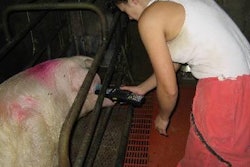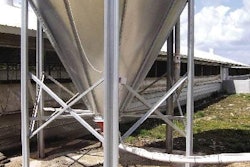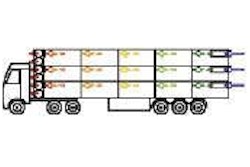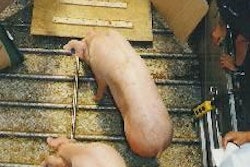.jpg?auto=format%2Ccompress&q=70&w=400)
China's pig sector is noted internationally for its huge size, but it also continues to move ahead in terms of consolidation, expertise and production levels. So-called commercial or intensive farms (defined as more than 50 sows per farm) can be found in increasing numbers around the major cities. Most are basically echoes of the western pig production model and some even reflect ideas in other parts of the world by forming part of an overall integration involving breeder and feed supplier as well as contract finisher.
In 2006 the relatively high feed input prices confronting pig producers were countered by good farm-gate prices. Chinese specialists calculate that the current average cost of production on their commercial units is around US$0.95 per kg of liveweight pig, with 75% or more of that being feed costs. Compare that with the recent farm-gate price in a major city like Guangzhou (Canton), of US$1.50 per kg.
Retail prices in a supermarket in Guangzhou, as in other cities, have hovered close to US$2.50 per kilogram, emphasising the fact that China still has low slaughter and distribution costs. Demand for the meat remains rather inelastic, however, which has created several supply-led booms and busts at times because the supplies come from an extremely large number of farms and there are no imports of pork to balance the equation.
Sometimes the shortage seems to be of data rather than pigmeat. For example, even today there is a lack of data about the percentage of the total market now taken up by ‘western' or pink-pig pork as opposed to the amount retained by the 40 or so popular native pigmeat breeds, such as Jinhua or Xiang.
Venture into the southern province of Jiangxi, however, and the temptation is to assume that western-style breeds and big-unit management are everywhere. Just such an impression might be formed after visiting Oo Fong Farms, a well-run operation of 3400 sows in Jiangxi that divides its production between multiple sites. These farms provide around 60 000 finishing pigs per year. Many go into the provincial market, but some are exported in the sense of being sent to Hong Kong.
The exports are good business. Customers in Hong Kong pay a premium price of about US$2.00/kg compared to the local US$1.50 price. Extra inputs are needed to reach the Hong Kong market, of course. Oo Fong must pay for auditing of medications and vaccines as well as extra transport costs. On the other side of the profit line it saves by locating its production sites in Jiangxi, since this is one of the less developed Chinese provinces at present where the typical wage rates for a farm worker are just 60 US cents per hour.
Visitors to Oo Fong Farms discover an enterprise with good management control of production and well-separated facilities for breeder, weaner and finisher pigs. It has separate on-site staff and delivery trucks for each phase of the operations. Health-wise, its pigs are fully vaccinated for viral diseases as well as for Mycoplasma. Recently the farms have started in-water oral vaccination against ileitis using Boehringer's Enterisol vaccine with good results less variation of the pigs at market weight and better growth rates, enabling more to be sent to Hong Kong rather than local markets. Interestingly, too, the purchasers in Hong Kong gave a warm welcome to the idea that the adoption of this vaccine would mean less use of finisher medications.
Western or pink-pig pork is certainly the only way to describe Oo Fong pigmeat, even if its seedstock is sourced locally. Like other big farms with western pigs, it derives its herd replacement animals from provincial swine breeding centres. These centres are either government-backed or run privately and have had ongoing imports of breeds such as Large White/Yorkshire and Landrace from sources such as the National Swine Registry in the USA.
One difference from the patterns seen in other countries is in the level of artificial insemination. Commercial units in China are more likely to use natural matings by boars on the farm, citing difficulties with AI studs developing proper distribution of semen supplies. Most of the farms make a considerable effort to purchase quality boars from their provincial breeding centre. Some of the centres, such as at Guangzhou, hold occasional boar auctions because of the demand.

















